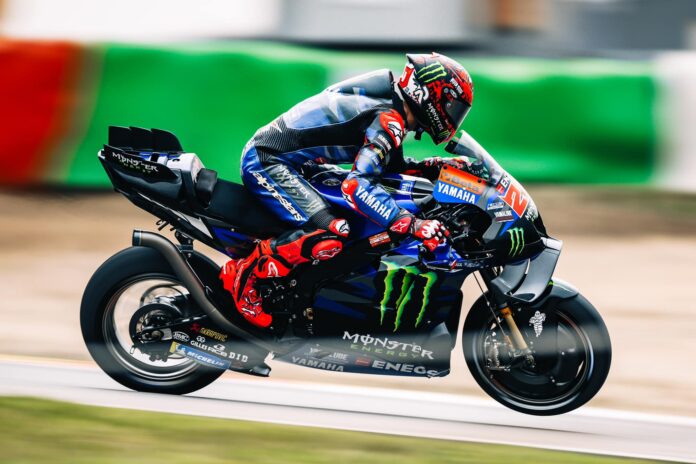Turning the Tide: Monster Yamaha’s Remarkable Comeback at Portimao MotoGP
In the high-octane world of MotoGP, the comeback story of Monster Yamaha riders Fabio Quartararo and Alex Rins at the Portimao MotoGP is nothing short of cinematic. From the lows of starting 16th and 20th in Qatar, to making a direct entry into Qualifying 2 at Portimao, this tale is all about overcoming adversity, technical savvy, and the sheer will to win.
Dusting Off the Challenges: A Gritty Performance
The Portimao track, known for its demanding conditions, did not make things any easier with its dusty and low-grip surface. Yet, against the odds and the track’s notoriously tricky conditions, Quartararo and Rins managed to secure the 9th and 10th spots, respectively, in Friday’s session. This was a mere 0.008s gap between them and a challenging half-second off the leading pace of Ducati’s Enea Bastianini. The M1 bikes, often criticized for their struggle in low grip situations, showcased a remarkable level of adaptability and performance, hinting at a potential resurgence of Yamaha in the MotoGP pecking order.

The Quest for Grip: Yamaha’s Strategic Pivot
The focus on electronics as a significant area of improvement was a central theme in Quartararo’s reflection on the day’s performance. Acknowledging the gap in their setup, he highlighted an intensive focus on adjusting the electronics to better harness the bike’s power and grip. This strategic pivot is crucial, considering the M1’s historical difficulty in extracting maximum grip for time attacks. Quartararo’s insight into their approach reveals a blend of optimism and realism – a recognition of the need for incremental improvements rather than expecting overnight success.
Team Dynamics: The Rins and Quartararo Synergy
Alex Rins echoed a sentiment of achievement, emphasizing the continuity in bike specification from Qatar to Portimao but noting a significant improvement in confidence and adaptability to the track. His ability to qualify directly into Q2, overcoming previous challenges, including a leg issue, marks a significant personal and team milestone. Rins and Quartararo, with their nuanced yet compatible riding styles, especially in their approach to electronics, are shaping up to be a formidable pair for the Yamaha team. This synergy, coupled with the upcoming introduction of new parts in the private test post-Portimao, signals an exciting phase of development and potential for the team.
The Road Ahead: Optimism and Challenges
As Monster Yamaha gears up for the rest of the weekend and beyond, the mood in the camp is cautiously optimistic. The acknowledgment of the M1’s current limitations by team boss Massimo Meregalli, juxtaposed with the evident potential for improvement, sets a realistic yet hopeful tone for the future. The riders’ ability to adapt their styles, coupled with strategic technical adjustments, particularly in electronics, presents a pathway to closing the gap with their competitors.
The story of Quartararo and Rins at Portimao is more than just about qualifying positions; it’s a narrative of resilience, technical ingenuity, and the relentless pursuit of excellence. As the MotoGP season unfolds, all eyes will be on Monster Yamaha to see if this comeback tale heralds a new chapter of competitiveness and success for the team.
FAQs: Monster Yamaha’s Performance at Portimao MotoGP
Why did Quartararo and Rins struggle at the start of the season?
At the beginning of the season in Qatar, both Quartararo and Rins faced challenges with their Yamaha M1 bikes, primarily due to difficulties in adapting to the track conditions and extracting maximum performance from their machines. The M1 struggled with grip in the low-traction conditions, affecting their qualifying positions and overall performance.
How did they manage to bounce back at Portimao?
Despite the dusty and low-grip conditions at Portimao, which are typically challenging for the Yamaha M1, both riders adapted well. They focused on fine-tuning their bikes, especially the electronics, to improve grip and performance. Their efforts paid off, with both riders securing positions in the top 10 during Friday’s session and qualifying directly for Q2.
What changes did Quartararo make to improve his performance?
Quartararo mentioned that after the learning experience in Qatar, they adjusted their riding style significantly. Additionally, a major focus was placed on tweaking the electronics to optimize performance. These changes were aimed at better managing the bike’s power output and improving tire grip during time attacks.
How does Alex Rins compare his performance in Portimao to Qatar?
Rins highlighted that while the bike specification remained the same as in Qatar, his confidence and adaptability to the Portimao track improved greatly. His ability to directly qualify for Q2 at Portimao was a significant achievement, especially considering his struggles with a leg issue in the past and the challenges he faced in earlier races.
What are Yamaha’s plans for further improvements?
Yamaha plans to introduce new parts and further adjustments during Monday’s private test following the Portimao race. Both riders, especially Rins, emphasized the ongoing need to gather information and make incremental improvements to their bikes, focusing on similar areas of improvement identified in Qatar.
How does the teamwork between Rins and Quartararo benefit Yamaha?
The synergy between Rins and Quartararo is proving beneficial for Yamaha. Despite having slightly different riding styles, especially concerning the use of electronics, their ability to perform closely and share insights helps the team in fine-tuning their strategies and bike setups. This teamwork is crucial for overcoming the technical challenges faced by Yamaha and pushing for better results in future races.
What does Yamaha’s performance in Portimao indicate for the rest of the season?
Yamaha’s performance in Portimao, particularly the ability of its riders to overcome adverse conditions and qualify well, signals a positive trajectory for the team. While there are still areas for improvement, the adaptability and resilience shown by Quartararo and Rins suggest that Yamaha can be competitive and potentially close the gap with its rivals as the season progresses.


































